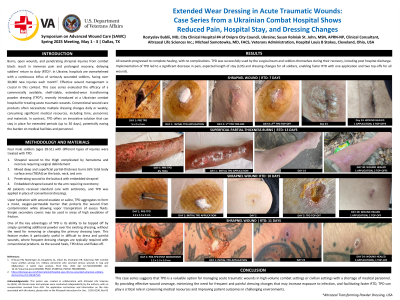Practice Innovations
(PI-004) Extended Wear Dressing in Acute Traumatic Wounds: Case Series from a Ukrainian Combat Hospital Shows Reduced Pain, Hospital Stay, and Dressing Changes

Burns, open wounds, and penetrating shrapnel injuries from combat blasts result in immense pain and prolonged recovery, delaying soldiers' return to duty1. In Ukraine, hospitals are overwhelmed with a continuous influx of seriously wounded soldiers, facing over 30,000 new injuries each month2. Conventional wound care products often necessitate multiple dressing changes per day or week, consuming significant medical resources, including time, personnel and materials. Utilizing innovative transforming powder dressings (TPD) that stay in place for extended periods (up to 30 days) can potentially ease the burden on medical facilities and personnel. This case series details four wounded soldiers who were treated with TPD instead of conventional dressings, and describes the outcomes related to frequency of dressing changes, wound complications, wound related pain, and hospital length of stay using TPD.
Methods:
Four male soldiers (ages 28-51) with different types of acute traumatic injuries were treated with TPD, including one burn wound and three penetrating shrapnel wounds. All patients received standard care with antibiotics and analgesics, and TPD was applied in place of conventional dressings. Upon hydration with saline, TPD aggregates to form a moist, oxygen-permeable barrier that protects the wound from contamination and supports healing by allowing vapor transpiration of excess fluids. Simple secondary dressings were used over the TPD.
Results:
In all four cases, TPD was successfully used by the surgical team and the soldiers themselves during their recovery, including after discharge from the hospital. The soldiers reported a significant reduction in wound-related pain. The use of TPD also facilitated earlier discharge from the hospital (than anticipated for patients receiving conventional wound care treatments), as the wounds continued to heal effectively and were easily managed in combat conditions, with reduced frequency of dressing changes. Throughout the treatment, no complications were observed, and all wounds progressed to complete healing.
Discussion:
This case series suggests that TPD is a valuable option for managing acute traumatic wounds in high-volume combat or civilian settings with a shortage of personnel and resources. TPD can play a critical role in conserving medical resources and improving patient outcomes in challenging environments.

.jpg)